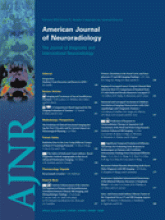Research ArticlePediatrics
Efficiency of Fractional Anisotropy and Apparent Diffusion Coefficient on Diffusion Tensor Imaging in Prognosis of Neonates with Hypoxic-Ischemic Encephalopathy: A Methodologic Prospective Pilot Study
O. Brissaud, M. Amirault, F. Villega, O. Periot, J.F. Chateil and M. Allard
American Journal of Neuroradiology February 2010, 31 (2) 282-287; DOI: https://doi.org/10.3174/ajnr.A1805
O. Brissaud
M. Amirault
F. Villega
O. Periot
J.F. Chateil

References
- 1.↵
- Wayenberg JL,
- Vermeylen D,
- Damis E
- 2.↵
- Adamson SJ,
- Alessandri LM,
- Badawi N,
- et al
- 3.↵
- Ekert P,
- Perlman M,
- Steinlin M,
- et al
- 4.↵
- Finer NN,
- Robertson CM,
- Richards RT,
- et al
- 5.↵
- Smith J,
- Wells L,
- Dodd K
- 6.↵
- Thornberg E,
- Thiringer K,
- Odeback ,
- et al
- 7.↵
- Gosselin J,
- Gahagan S,
- Amiel-Tison C
- 8.↵
- Sarnat HB,
- Sarnat MS
- 9.↵
- Brissaud O,
- Chateil JF,
- Bordessoules M,
- et al
- 10.↵
- Rutherford M,
- Counsell S,
- Allsop J,
- et al
- 11.↵
- Barkovich AJ,
- Miller SP,
- Bartha A,
- et al
- 12.↵
- Malik GK,
- Trivedi R,
- Gupta RK,
- et al
- 13.↵
- Ward P,
- Counsell S,
- Allsop J,
- et al
- 14.↵
- van Pul C,
- Buijs J,
- Janssen MJ,
- et al
- 15.↵
- Bartha AI,
- Yap KR,
- Miller SP,
- et al
- 16.↵
- Cascio CJ,
- Gerig G,
- Piven J
- 17.↵
- Hermoye L,
- Saint-Martin C,
- Cosnard G,
- et al
- 18.↵
- Miller SP,
- McQuillen PS,
- Hamrick S,
- et al
- 19.↵
- Mukherjee P,
- Miller JH,
- Shimony JS,
- et al
- 20.↵
- Meyer-Witte S,
- Brissaud O,
- Brun M,
- et al
- 21.↵
- Pajevic S,
- Pierpaoli C
- 22.↵
- Wakana S,
- Jiang H,
- Nagae-Poetscher LM,
- et al
- 23.↵
- 24.↵
- Snook L,
- Plewes C,
- Beaulieu C
- 25.↵
- Mandelli ML,
- De Simone T,
- Minati L,
- et al
- 26.↵
- Sidaros A,
- Engberg AW,
- Sidaros K,
- et al
- 27.↵
- Thomalla G,
- Glauche V,
- Koch MA,
- et al
- 28.↵
- Liauw L,
- van der Grond J,
- van den Berg-Huysmans AA,
- et al
- 29.↵
- Hunt RW,
- Neil JJ,
- Coleman LT,
- et al
- 30.↵
- Wolf RL,
- Zimmerman RA,
- Clancy R,
- et al
- 31.↵
- Vermeulen RJ,
- van Schie PE,
- Hendrikx L,
- et al
- 32.↵
- Liauw L,
- van Wezel-Meijler G,
- Veen S,
- et al
- 33.↵
- Groenendaal F,
- Benders MJ,
- de Vries LS
- 34.↵
- Domi T,
- deVeber G,
- Shroff M,
- et al
In this issue
Advertisement
O. Brissaud, M. Amirault, F. Villega, O. Periot, J.F. Chateil, M. Allard
Efficiency of Fractional Anisotropy and Apparent Diffusion Coefficient on Diffusion Tensor Imaging in Prognosis of Neonates with Hypoxic-Ischemic Encephalopathy: A Methodologic Prospective Pilot Study
American Journal of Neuroradiology Feb 2010, 31 (2) 282-287; DOI: 10.3174/ajnr.A1805
0 Responses
Efficiency of Fractional Anisotropy and Apparent Diffusion Coefficient on Diffusion Tensor Imaging in Prognosis of Neonates with Hypoxic-Ischemic Encephalopathy: A Methodologic Prospective Pilot Study
O. Brissaud, M. Amirault, F. Villega, O. Periot, J.F. Chateil, M. Allard
American Journal of Neuroradiology Feb 2010, 31 (2) 282-287; DOI: 10.3174/ajnr.A1805
Jump to section
Related Articles
Cited By...
- Apparent Diffusion Coefficient Scalars Correlate with Near-Infrared Spectroscopy Markers of Cerebrovascular Autoregulation in Neonates Cooled for Perinatal Hypoxic-Ischemic Injury
- Therapeutic Hypothermia for Neonatal Encephalopathy Results in Improved Microstructure and Metabolism in the Deep Gray Nuclei
- Impact of therapeutic hypothermia on MRI diffusion changes in neonatal encephalopathy
- Does Diffusion Tensor Imaging-Based Tractography at 3 Months of Age Contribute to the Prediction of Motor Outcome After Perinatal Arterial Ischemic Stroke?
This article has been cited by the following articles in journals that are participating in Crossref Cited-by Linking.
- N. Bednarek, A. Mathur, T. Inder, J. Wilkinson, J. Neil, J. ShimonyNeurology 2012 78 18
- Leonardo Guilhermino Gutierrez, Àlex Rovira, Luiz Antonio Pezzi Portela, Claudia da Costa Leite, Leandro Tavares LucatoNeuroradiology 2010 52 11
- Nora Tusor, Courtney Wusthoff, Natalie Smee, Nazakat Merchant, Tomoki Arichi, Joanna M. Allsop, Frances M. Cowan, Denis Azzopardi, A. David Edwards, Serena J. CounsellPediatric Research 2012 72 1
- Sonia K. Ghei, Elcin Zan, Jennifer E. Nathan, Asim Choudhri, Aylin Tekes, Thierry A. G. M. Huisman, Izlem IzbudakRadioGraphics 2014 34 4
- Niek E. van der Aa, Alexander Leemans, Frances J. Northington, Henrica L. van Straaten, Ingrid C. van Haastert, Floris Groenendaal, Manon J.N.L. Benders, Linda S. de VriesStroke 2011 42 12
- An N Massaro, Iordanis Evangelou, Ali Fatemi, Gilbert Vezina, Robert Mccarter, Penny Glass, Catherine LimperopoulosDevelopmental Medicine & Child Neurology 2015 57 5
- A. Tekes, A. Poretti, M. M. Scheurkogel, T. A. G. M. Huisman, J. A. Howlett, E. Alqahtani, J.- H. Lee, C. Parkinson, K. Shapiro, S.- E. Chung, J. M. Jennings, M. M. Gilmore, C. W. Hogue, L. J. Martin, R. C. Koehler, F. J. Northington, J. K. LeeAmerican Journal of Neuroradiology 2015 36 1
- Valérie Charon, Maïa Proisy, Gilles Bretaudeau, Bertrand Bruneau, Patrick Pladys, Alain Beuchée, Gladys Burnouf-Rose, Jean-Christophe Ferré, Céline RozelEuropean Journal of Radiology 2016 85 8
- S.L. Bonifacio, A. Saporta, H.C. Glass, P. Lee, D.V. Glidden, D.M. Ferriero, A.J. Barkovich, D. XuAmerican Journal of Neuroradiology 2012 33 11
- Shasha Liu, Xiaoli Zhang, Yanchao Liu, Xiao Yuan, Lin Yang, Ruili Zhang, Xiaoan Zhang, Xiaoyang Wang, Falin Xu, Changlian ZhuRespiratory Physiology & Neurobiology 2020 281
More in this TOC Section
Similar Articles
Advertisement











